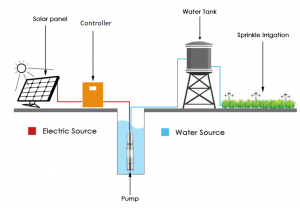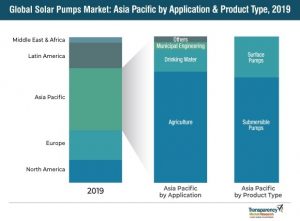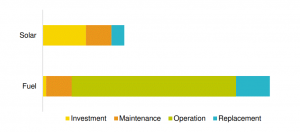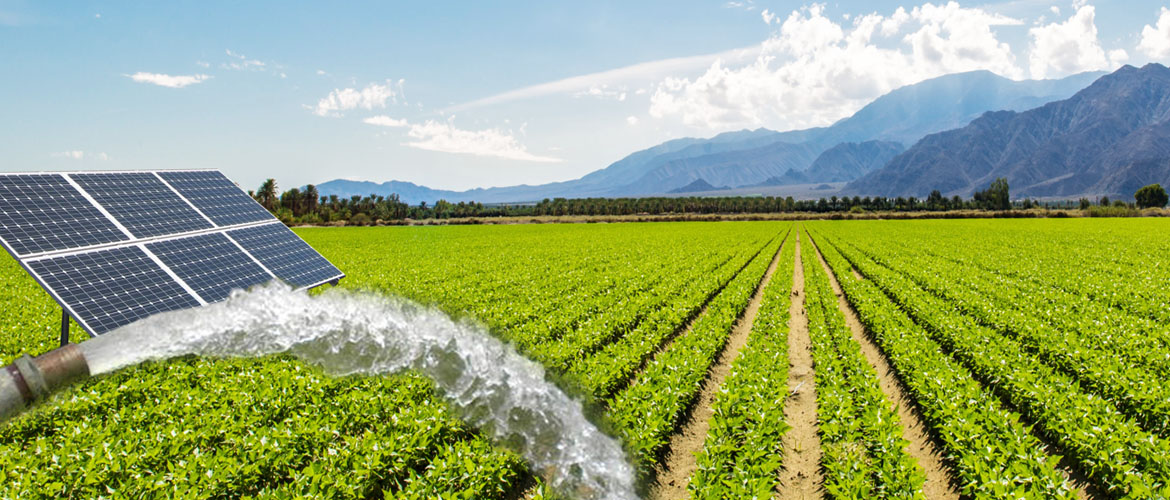SOLAR PUMPING
Simple, Reliable, and Cost Effective
In times when solar is becoming the global trend, utilizing the sun for water pumping systems can significantly help and accelerate the development of the agriculture sector especially in remote areas where other electricity sources are scarce to find. This concept is known as solar-powered irrigation and is being adopted in many regions around the world.
What is Solar water pumping?
Solar pumps present a clean, simple and energy-efficient alternative to traditional electric and fuel-driven pump sets. They are classified as an environmentally friendly solution in the agricultural sector.
A solar water pump system is essentially an electrical pump system in which the electricity is provided by Photovoltaic solar panels. A typical solar powered pumping system consists of a solar panel array connected to a controller that powers directly the electric motor of the pump. The water is usually pumped out from the ground or stream into a storage reservoir dragged to the irrigation points by gravity.
Solar water pumping systems can be classified as either direct current (DC) or alternating current (AC) systems based on their motor’s ability. Recently, the concept of brushless DC (BLDC) motors for solar pumping water applications was presented as well.
The main aspect related to the efficiency of a solar water pump is based on three variables including pressure, flow and input power to the pump.
 Specifying the right flow and pressure needed to extract the water from the well allows us to select the right pump size required to do the job. Then based on the pump’s electrical specifications and the total daily, monthly and yearly water volumes needed we can simulate the right solar panel array size. The solar panels are then connected to the pump via a smart controller that orchestrates the pump’s activity based on the sun’s irradiation. Technically, this controller will use variable frequency to control the pump’s power proportionally to the sun’s irradiation, hence pump out a proportional amount of water out of the well. As simple as it sounds, no complicated components are needed, no conventional fuel or generators are involved, and even no storage batteries! As long as the sun is there, water will be pumped out proportionally.
Specifying the right flow and pressure needed to extract the water from the well allows us to select the right pump size required to do the job. Then based on the pump’s electrical specifications and the total daily, monthly and yearly water volumes needed we can simulate the right solar panel array size. The solar panels are then connected to the pump via a smart controller that orchestrates the pump’s activity based on the sun’s irradiation. Technically, this controller will use variable frequency to control the pump’s power proportionally to the sun’s irradiation, hence pump out a proportional amount of water out of the well. As simple as it sounds, no complicated components are needed, no conventional fuel or generators are involved, and even no storage batteries! As long as the sun is there, water will be pumped out proportionally.
Solar Pumping in the Middle East and Africa
The Middle East and Africa region has high levels of sunshine, making solar an attractive solution. It is also significantly noticeable that the demand for solar pumps in this region is rapidly escalating, becoming the new norm for agriculture projects.
Although some areas in Africa are considered the poorest and most remote regions in the world, still they are privileged with abundant water sources and high sun irradiations. In fact, Africa is known to possess 9% of the world’s freshwater resources which translates to around 4,000 km3 of water per year. Therefore, deploying solar water pumps in Africa is the perfect alternative to any other fuel-based solution, and can be a very practical and low cost alternative which can stimulate life in every part of this continent.
 Global Outlook
Global Outlook
Knowing that 40% of the global population relies on agriculture as its main source of income, access to water remains an ongoing struggle for many people. This is what solar pumping aims to solve, by introducing a cost-effective solution for an anticipated 500 million small-scale farmers all around the world.
Asia Pacific and the Middle East & Africa are expected to witness substantial growth in solar pumping, due to extensive agriculture lands and the need to reduce the use of conventional energy sources. Government initiatives toward pollution-free and clean energy are also expected to boost the solar pumps markets in these regions. Moreover, a drop down in solar prices is further catalyzing the growth of the solar pumps market.
On the other hand, developing countries, such as India, China, Bangladesh, and Australia are expected to boom their investments in solar, including solar pumping, aiming to hit their pledge of reducing their emission footprints. Below graph compares the solar pumping market sizes among regions around the world, and also classifies them by application and product type.

The growing adoption of solar energy for irrigation and agriculture activities across the globe is the major driving factor of the solar pumps market. In terms of revenue, the global solar pumps market is estimated to expand at a compounded annual growth rate of 12% within the next years to reach a value of USD 3.1 bn by 2027. There are many key drivers to this fact, among which we list:
1. Ongoing ramp-down of solar panels prices is making the solar pumping solution more cost beneficial
2. Continual growth in agriculture sector which proportionally peeks up the need of irrigation water supply
3. Growing government support for the agricultural sector
4. Inevitable future scarcity of fossil fuels, making solar the best alternative solution
5. Global trends towards eco-friendly alternative solutions, putting the solar pumps in the forefront of the other oil-based conventional pumping solutions
Technology Advantages & Disadvantages
Just as any other technology, solar pumping has its advantages and disadvantages compared to the conventional fuel-based pumping methods. However, weighing the cons and pros, this technology remains to be un-doubtfully superior over the conventional method in many ways. Below we demonstrate those differences:
Advantages:
Solar pumps are sustainable and have almost zero technical and financial overhead
Solar pumps use renewable energy and solar panels hence are environment friendly
Solar pumps are very reliable with a long life span, up to 25 years for the solar panels
Solar pumps powered by solar panels are independent of diesel and electricity hence cost-saving and reliable in remote areas where fuel and grid is not available
Disadvantages:
Solar pumps do not work at night in areas without a grid hence we are obliged to collect the needed water only in daytime
Solar pumping is affected by the intensity of sunlight hence need an accurate design and simulation prior to selection and installation
Solar pumping upfront costs are higher than conventional pumping and can be a barrier to some farmers.
Are solar water pumps worth the investment?
Speaking facts, solar energy has proven to be the easiest way for farmers to produce energy, especially for those deprived of utility grids or with poor electricity infrastructure. Therefore, the use of solar water pumps in agriculture is becoming the new trend. The concept of solar irrigation represents a logical and coherent application: Crops need water most in sunny days, and in those days solar pumping can produce the largest amount of water. The more the sun is, the thirstier the crops are, and the more pumping we can achieve!
Having previously listed the major cons and pros of this technology, it is important to note that the disadvantages are not that severe and can be easily overcome especially once we think of the definite outweighing of the advantages. For example, when it comes to the initial investment, the costs have dropped significantly in the past few years and is still expected to drop along the coming years. (price drop of 59% according to a new research from the IRENA International Renewable Energy Agency compared to 2015 prices).
Moreover, infographic from The World Bank shows that the average price of a solar panel per watt was $0.75 in 2012, and dropped to around $0.25 in 2020. This clearly demonstrates the dramatic plunge in prices. Not to forget, a solar panel has an average lifespan of 25 years and compared to diesel pumping, it lacks any fuel and presents less operation and maintenance. Therefore, the disadvantage of its initial cost will still be acceptable when we look at the overall savings and the way lower overheads during its lifetime.

20-year life cycle cost comparison between solar-powered water pumps and traditional fuel-driven pumps.
Source: Solar Water Pump Technology Roadmap
As shown in the graph, diesel pumps may have low initial investment costs but they incur high operation and maintenance costs, not to mention their undesirable impact on the environment and ecology. In contrary, a solar water pumping system has higher, yet reasonable, investment costs but lower maintenance and operational costs. Speaking in figures, latest ROI analysis pertaining to solar pumping projects have calculated in many cases payback periods of as low as 2 years, which makes it unquestionably a very appealing investment!

